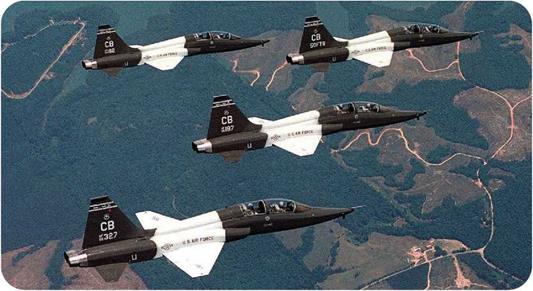G-Forces
Fighter planes sometimes have to make extremely tight turns in combat. The acceleration forces caused by these tight turns are often called g-forces because they are measured by comparing them to the force of gravity at Earth’s surface. An acceleration force equal to Earth’s surface gravity is 1g. A force twice as strong as this is 2g, and so on up the g-force scale.
The human body can survive g-forces as high as about 40g, but only for a brief time. People who ride on the most extreme theme park rides normally experience acceleration forces of up to about 4g. Fighter pilots train to withstand g-forces up to about 9g.
Forces as strong as 9g pull blood from a pilot’s head down into the body and legs. Without any protective clothing or training, the pilot would faint from lack of blood in the brain. This type of fainting is also called g-loc, which stands for g-induced loss of consciousness. Pilots get some warning of g-loc
because the shortage of blood in their head causes problems with their vision.
Fighter pilots protect themselves from g-loc by wearing an anti-g suit. In a tight turn, air is pumped into the suit’s body and legs. It squeezes the pilot’s body and legs to stop blood from draining down out of his or her head. Pilots also tense the muscles in their bodies to push more blood up into their heads, but this straining maneuver is very tiring. Pilots can be helped by one more system: Oxygen-rich air is forced into their lungs through a facemask. Air also must be pumped into an inflatable vest, which presses the pilot’s chest with equal force.
Fighter pilots can experience negative g-forces, the forces that act in the opposite direction to gravity. A negative g-force forces extra blood up into a pilot’s head. This causes an effect called red-out, because the pilot’s vision turns red. Pilots can only withstand negative g-forces of about -2g or -3g at most.
UNITS OF FORCE
The units used for measuring force include the newton and the pound force. The newton is the international unit of force. It is the force needed to make a mass of 1 kilogram accelerate at 1 meter per second squared (or per second per second). This force is roughly the same force as the weight of a 3.5-ounce (about 100- gram) object-a small apple, for example. The pound force is the weight of a mass of 1 pound (0.454 kilogram).
_____________________________________________ /
N
SEE ALSO:
• Gravity • Jet and Jet Power
• Laws of Motion • Lift and Drag
• Thrust • Weight and Mass

 |
_____________________________________________ J










